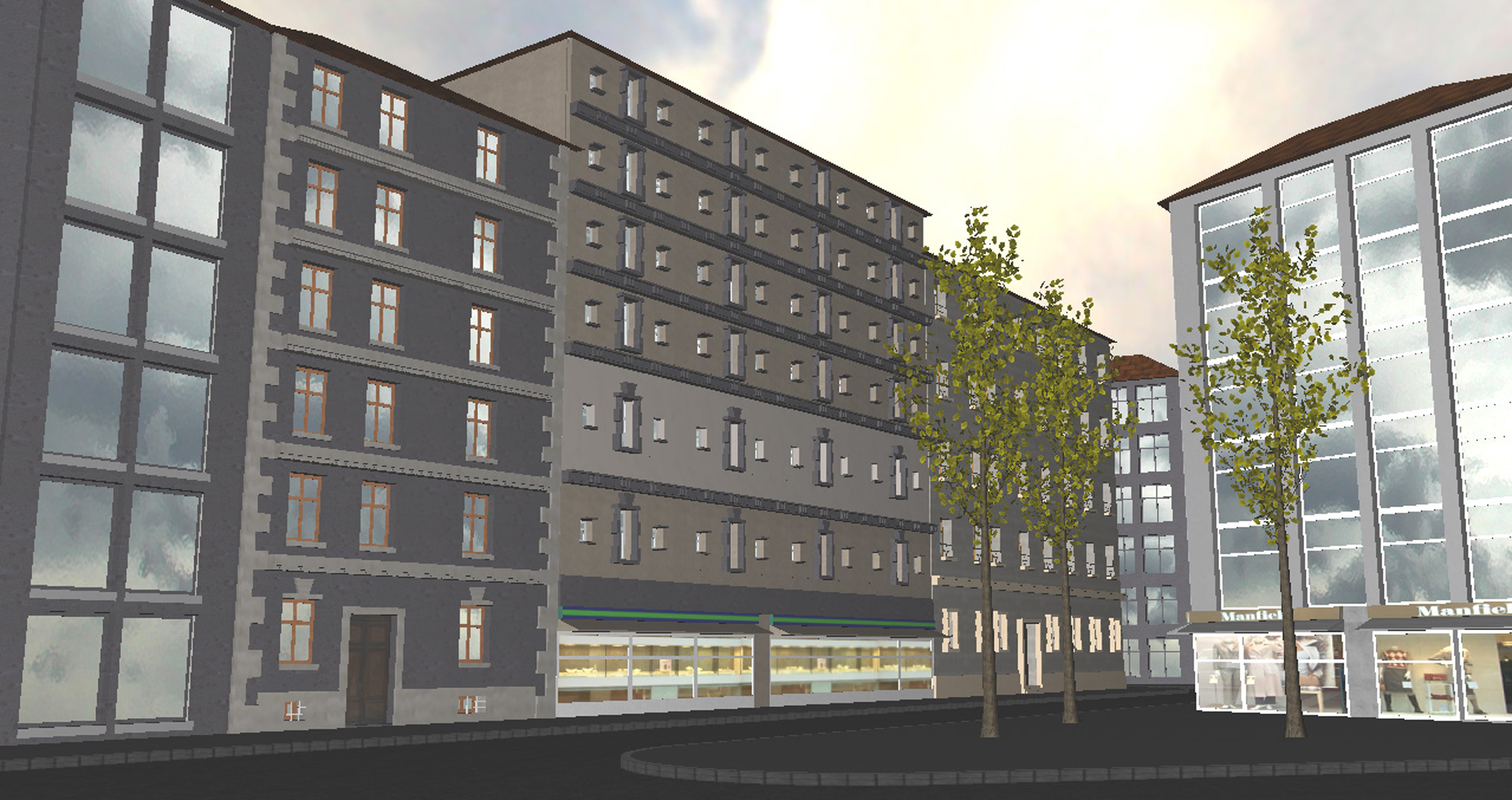“Instant architecture” by Wonka, Wimmer, Sillion and Ribarsky
Conference:
Type(s):
Title:
- Instant architecture
Presenter(s)/Author(s):
Abstract:
This paper presents a new method for the automatic modeling of architecture. Building designs are derived using split grammars, a new type of parametric set grammar based on the concept of shape. The paper also introduces an attribute matching system and a separate control grammar, which offer the flexibility required to model buildings using a large variety of different styles and design ideas. Through the adaptive nature of the design grammar used, the created building designs can either be generic or adhere closely to a specified goal, depending on the amount of data available.
References:
1. ALEXANDER, C., ISHIKAWA, S., AND SILVERSTEIN, M. 1977. A Pattern Language: Towns, Buildings, Construction. Oxford University Press, New York.Google Scholar
2. ALEXANDER, C. 1965. A city is not tree. Architectural Forum 122 22, 1, 58–61.Google Scholar
3. DEBEVEC, P. E., TAYLOR, C. J., AND MALIK, J. 1996. Modeling and rendering architecture from photographs: A hybrid geometry- and image-based approach. In Proceedings of ACM SIGGRAPH 96, ACM Press, H. Rushmeier, Ed., 11–20. Google Scholar
4. DICK, A., TORR, P., RUFFLE, S., AND CIPOLLA, R. 2001. Combining single view recognition and multiple view stereo for architectural scenes. In Proceedings of the Eighth International Conference On Computer Vision (ICCV-01), IEEE Computer Society, Los Alamitos, CA, 268–274.Google Scholar
5. DOWNING, F., AND FLEMMING, U. 1981. The bungalows of buffalo. Environment and Planning B 8, 269–293.Google ScholarCross Ref
6. DUARTE, J. 2002. Malagueira Grammar — towards a tool for customizing Alvaro Siza’s mass houses at Malagueira. PhD thesis, MIT School of Architecture and Planning.Google Scholar
7. FLEMMING, U. 1987. More than the sum of its parts: the grammar of queen anne houses. Environment and Planning B 14, 323–350.Google ScholarCross Ref
8. HILLIER, B. 1996. Space Is The Machine: A Configurational Theory Of Architecture. Cambridge University Press.Google Scholar
9. JEPSON, W., LIGGETT, R., AND FRIEDMAN, S. 1996. Virtual modeling of urban environments. PRESENCE 5, 1, 72–86.Google ScholarDigital Library
10. KARNER, K., BAUER, J., KLAUS, A., LEBERL, F., AND GRABNER, M. 2001. Virtual habitat: Models of the urban outdoors. In Third International Workshop on Automatic Extraction of Man-Made Objects from Aerial and Space Imaging, 393–402.Google Scholar
11. KONING, H., AND EIZENBERG, J. 1981. The language of the prairie: Frank lloyd wrights prairie houses. Environment and Planning B 8, 295–323.Google ScholarCross Ref
12. LEGAKIS, J., DORSEY, J., AND GORTLER, S. J. 2001. Feature-based cellular texturing for architectural models. In Proceedings of ACM SIG-GRAPH 2001, ACM Press, E. Fiume, Ed., 309–316. Google Scholar
13. LEYTON, M. 2001. A Generative Theory of Shape. Springer-Verlag, Berlin. Google Scholar
14. LYNCH, K. 1960. The Image of the City. MIT Press.Google Scholar
15. MARCH, L., AND STEADMAN, P. 1974. The Geometry of Environment. MIT Press.Google Scholar
16. MĚCH, R., AND PRUSINKIEWICZ, P. 1996. Visual models of plants interacting with their environment. In Proceedings of ACM SIGGRAPH 96, ACM Press, H. Rushmeier, Ed., 397–410. Google Scholar
17. MITCHELL, W. J. 1990. The Logic of Architecture: Design, Computation, and Cognition. MIT Press. Google Scholar
18. MOSER, F., MAYERHOFER, R., AND FREI, W. 1985. Charakteristik der Stadtgestalt Wien — Grundlage für Stadterneuerung und Wohnbau. Technical report, Institute of Local Planning, Vienna University of Technology.Google Scholar
19. PARISH, Y. I. H., AND MÜLLER, P. 2001. Procedural modeling of cities. In Proceedings of ACM SIGGRAPH 2001, ACM Press, E. Fiume, Ed., 301–308. Google Scholar
20. PRUSINKIEWICZ, P., AND LINDENMAYER, A. 1991. The Algorithmic Beauty of Plants. Springer-Verlag. Google Scholar
21. PRUSINKIEWICZ, P., JAMES, M., AND MĚCH, R. 1994. Synthetic topiary. In Proceedings of ACM SIGGRAPH 94, ACM Press, A. Glassner, Ed., 351–358. Google Scholar
22. REALVIZ, 2002. Image modeler product information. http://www.realviz.com.Google Scholar
23. RIBARSKY, W., WASILEWSKI, T., AND FAUST, N. 2002. From urban terrain models to visible cities. IEEE Computer Graphics & Applications 22, 4, 231–238. Google ScholarDigital Library
24. SHLYAKHTER, I., ROZENOER, M., DORSEY, J., AND TELLER, S. 2001. Reconstructing 3D tree models from instrumented photographs. IEEE Computer Graphics and Applications 21, 3 (May/June), 53–61. Google ScholarCross Ref
25. SHUBNIKOV, A. V., AND KOPTSIK, V. A. 1974. Symmetry in Science and Art. Plenum Press, New York.Google Scholar
26. STINY, G., AND MITCHELL, W. J. 1978. The palladian grammar. Environment and Planning B 5, 5–18.Google ScholarCross Ref
27. STINY, G. 1975. Pictorial and Formal Aspects of Shape and Shape Grammars. Birkhauser Verlag, Basel.Google Scholar
28. STINY, G. 1980. Introduction to shape and shape grammars. Environment and Planning B 7, 343–361.Google ScholarCross Ref
29. STINY, G. 1980. Production systems and grammars: a uniform characterization. Environment and Planning B 7, 399–408.Google ScholarCross Ref
30. STINY, G. 1982. Spatial relations and grammars. Environment and Planning B 9, 313–314.Google ScholarCross Ref
31. TELLER, S., 2001. Mit city scanning project: Fully automated model acquisition in urban areas. http://city.lcs.mit.edu//city.html.Google Scholar
32. WEI, L.-Y., AND LEVOY, M. 2000. Fast texture synthesis using tree-structured vector quantization. In Proceedings of ACM SIGGRAPH 2000, ACM Press, K. Akeley, Ed., 479–488. Google Scholar
33. WEYL, H. 1952. Symmetry. Princeton University Press.Google Scholar




